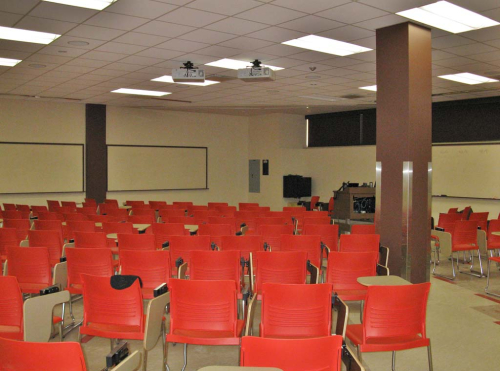- Location: 21111 Lakeshore Road, Ste-Anne-de-Bellevue, QC
- Capacity: 120 students
- Type: Flat classroom
Alignment with principles for designing Teaching and Learning Spaces
Academic challenge
Promote individual, active engagement with content.
Layout
Large tablet work surface for notebooks, laptops, or textbooks.
Acoustics: Acoustic design to avoid distraction from outside and inside sources.
Furniture
Lightweight chairs permit students to work individually or in groups.
Technologies
Access to resources: LMS, internet (via student laptops). Dual-source projection and multiple screens permit simultaneous display of different learning materials.
Lighting & colour
Appropriate lighting for individual work.

Learning with peers
Promote active engagement with one another.
Layout
Flexible layout permits students to move easily from small group to larger group activities.
Acoustics: Sound zones support multiple simultaneous conversations among students.
Furniture
Lightweight chairs permit students to turn and discuss with those nearby, and allow for easy reconfiguration of the classroom to support a variety of collaborative learning approaches.
Technologies
Whiteboards wrap the room, providing ample shared workspace for student brainstorming, work on projects, and presenting.
Lighting & colour
Large windows bring in natural light, and lighting fixtures provide additional light.

Experiences with faculty
Promote interaction and communication.
Layout
Instructor is not limited to the “front of the room” and instead has access to all students due to mobile furniture and multiple aisles between the chairs. Chairs can be set up in different configurations according to the pedagogical activity and goals.
Acoustics: Sound zones ensure that not only are students able to hear the instructor, but that the instructor is also able to hear the students.
Furniture
A small podium does not interfere with sightlines or movement, while still being large enough for all instructional materials. Mobile furniture supports different teaching strategies.
Technologies
Multiple classroom technology sources (document camera, data projector, Sympodium, Blu-Ray/DVD, etc.) permit display of different learning materials.
Lighting & colour
Lighting patterns support multiple types of teaching tasks; brightly coloured chairs visually add to the space.

Contributions to the campus environment
Classrooms that incorporate elements of active and collaborative learning are part of a vision for campus learning spaces of many different sizes. This classroom is designed for flexible furniture use and for all populations using the space: well-lit, with a standardized room control panel that simplifies instructors’ use of equipment in classrooms across campus. University standards were applied, including improved ventilation and sustainable building practices. IT is consistent with teaching and learning needs. Both physical and virtual affordances help maximize High Impact Practices (HIPs) for student learning within and beyond this classroom.
